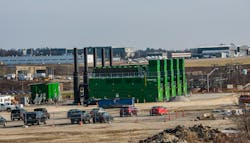2022 Airport Business Project of the Year: Pittsburgh's Microgrid Powers On
Pittsburgh International Airport (PIT) officially turned on it’s first of a kind microgrid over the summer of 2021. The 23 megawatt (MW) includes a 20 MW natural gas fired energy plant and a 3 MW solar facility and is the first installation of its kind in the world to completely provide power to an Airport.
The plant was designed, permitted, constructed, tested, and commissioned between October 2019 and June 2021. But what is a “microgrid?”
“A microgrid is an independent electricity source that can operate autonomously while maintaining a connection to the traditional grid. It is powered by natural gas drilled on-site by CNX Resources, in addition to gas from the interstate pipeline system and solar generation. The project offers a more efficient, sustainable and resilient source of energy. The microgrid consists of five natural gas-fired generators and 9,360 solar panels, capable of producing more than 20 megawatts of electricity,” explained Tom Woodrow, SVP Engineering & Intelligent Infrastructure, Allegheny County Airport Authority.
The Allegheny County Airport Authority Board of Directors, which operates and manages PIT, in 2019 awarded Peoples Natural Gas a 20-year contract to build, maintain and operate the microgrid at no cost to the airport. In addition to boosting power resiliency and redundancy, the microgrid achieves savings on electricity costs for the airport and tenants. Crews started construction in July 2020 and completed the project on schedule even as the pandemic stalled the aviation industry last year.
The microgrid has been providing all of the airport’s power since June 2021 and will continue to do so via a 20- year Energy Service Agreement. Savings are estimated at approximately $500,000 for the first year of operation with subsequent savings to be determined.
“Pittsburgh International Airport in June 2021 became the first airport in the world to be completely powered by natural gas and solar energy as part of its newly live microgrid. The first-of-its kind microgrid increases resilience and maximizes public safety and makes PIT one of the most site-hardened airports in the world,” said Woodrow.
The powered generated at PIT is the primary supply for the entire airport, including the terminals, airfield, Hyatt hotel and nearby gas station. The airport remains connected to the traditional electrical grid as an option for emergency or backup power if needed, noted Woodrow
Five 4.3 MW natural gas fired engines provide the power required of the airport, while maintaining reserve capacity and the ability to export power to the grid. The natural gas is sourced from 12 Marcellus natural gas wells located on airport property.
During normal operation the energy plant supports the airport load, using the existing connection with the local utility as a back-up power source in the event of a plant outage or emergency.
Due to plant synchronization with the grid, sourcing is seamless. Twenty-three airport owned meters, not connected to the internal electrical distribution, utilize green energy via virtual net-metering from the 3 MW of solar facility, which includes over 9,000 solar panels located on airport property.
“The solar facility covers approximately eight acres, and teams were able to construct it on a permitted/closed landfill that was used for the disposal of material from the construction of the airport in the late 1980s and early 1990s. Prior to construction, our teams received all the necessary permits from the Pennsylvania Department of Environmental Protection after a lengthy process,” Woodrow said
In the event of a region-wide power outage, where there is no grid power available, the microgrid is able to disconnect from the grid and operate in “Island Mode”, where the airport is able to fully operate with no grid power or connection to the grid. This Island mode capability is also accompanied by the ability to black start, meaning the generators are able to start on their own without any outside power available.
“Airports across the country have been exploring ways to increase power resilience and reliability after several high-profile power outages resulted in thousands of cancelled flights and passenger disruptions. As PIT is in the midst of a new terminal construction project building the smartest airport in the world, creating smart power infrastructure is a key step that can serve as a blueprint for others,” Woodrow continued.
Wooddrow said the benefits of the microgrid have so far been numerous, but fall into four main categories:
- Increase the power resilience of the airport
- Support the airport’s sustainability goals
- Decrease utility costs to the airport and our partners
- Support the local natural gas industry
“Some upgrades and improvements were needed to some existing electrical switchgear, and a new transformer was required to tie the energy plant into the existing airport electrical system. The teams were able to make use of significant spans of existing/spare underground conduit for new cables associated with the microgrid, which was very beneficial to the overall project,” Woodrow said.
Woodrow added that work on the microgrid did not interfere with airport operations. All testing with airport electrical systems was done overnight.
The microgrid is not only a benefit for the airport, but the surrounding community and environment. The microgrid allows Pittsburgh International Airport to be one of the most site-hardened airports in the world. The resilience and redundancy of the microgrid will allow the airport to stay open for business in the event of regional power outage. The microgrid enhances the overall customer experience and safety at the airport.
And natural gas is a cleaner burning fuel than traditional coal fired power plants. The use of natural gas for the energy generation is estimated to reduce CO2 emissions regionally by approximately 8,000,000 pounds per year
“This project capitalized on the Pittsburgh region’s innovation as well as abundant and low cost natural gas that can be used as fuel for generating electricity. The combination of technologies used on our project may not be the right approach for everyone. Additionally, projects like this require a lawyer who is experienced in alternative energy and microgrid developments. An experienced lawyer helps navigate the process – which will likely have technical and regulatory hurdles – and assists with developing a legal agreement that minimizes risk,” Woodrow said.
About the Author
Walker Jaroch
Editor
Contact: Walker Jaroch
Editor | AMT
+1-920-568-8399
>> To download the AviationPros media kits, visit: Marketing Resource Center
>>Check out our aviation magazines: Ground Support Worldwide | Airport Business | Aircraft Maintenance Technology

